Bob Vermillion
CPP/Felow
Certified, ESD Engineer-INARTE
RMV Technology Group, LLC
A NASA Industry Partner
During ESD assessments, it is not uncommon to see personnel wearing wool, silk, cotton, polyester blends and static control overalls (ESD Garments). Some ESD garment types consist of an embedded conductive grid network (Figure 1) in combination with cotton or polyester blends as seen under a digital microscope (Figure 1, left). Despite favorable cuff-to-cuff (Figure 2 right) or sleeveto- sleeve resistance (Figure 2, left) to ANSI/ESD STM2.1-2013 (see Table 2), some ESD garment types are charge generating. So, is a conductive grid network embedded in ESD garments (Figure 1) adequate for the prevention of triboelectrification or charge generation? (Note: This article does not address disposable garments.)


ANSI/ESD STM2.1 establishes requirements for taking point-to-point measurements as illustrated in Figure 2. One method utilizes special stainless steel garment clip electrodes (Figure 2) or two 5-pound NFPA electrodes (Figure 2) also illustrated in ANSI/ESD STM2.1.
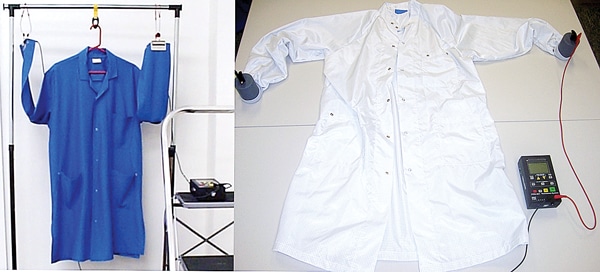
Recent testing by the Author found that although some ESD garments measured within the acceptance range of ANSI/ESD S20.20 for electrical resistance, electrostatic fields were still measured by a grounded operator wearing an ANSI/STM2.1 compliant garment. Based upon these findings for ESD garments, one may ask if there is a risk of ESD fabric charging in proximity to ultrasensitive ESD devices (HBM Class 0) under 50 volts? Will an electrostatic field facilitate an ESD event when contact is made by a grounded operator touching a circuit card or components with metal tweezers? Table 2 highlights the resistance requirements for ANSI/ESD STM2.1.
Three factors are necessary to produce an ESD event:
- Charge Generation
- Charge Accumulation
- Rapid Discharge
Therefore, it is important that a path to ground exists between a grounded operator and an ESD garment.
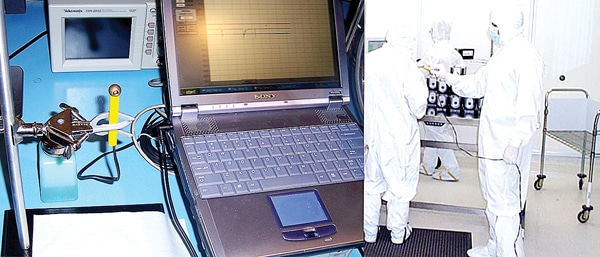
A few years ago, this same probe (as photographed in Figure 3) measured an operator wearing an ESD garment and conductive footwear on a conductive floor. Less than 50 volts was generated. (Figure 3 right). A non-contact voltage probe is utilized to determine peak electrostatic voltage.
For this article, the computer interfaced, non-contact probe system was positioned on an ESD safe workstation (Figure 3, left). During testing, the laptop computer (Figure 3, left) was moved 3’ away from the probe set-up so as not to influence the readings. The temperature and relative humidity (RH) measured 730F and 37%RH respectively. The Workmanship NASA-STD 8739.6 Page 16, Section 6.1 calls out the following:
6.1 Temperature and Relative Humidity (RH)
6.1.1 Temperature and relative humidity (RH) shall be monitored in the processing area and maintained within the following limits (Requirement):
- For temperature: 18° – 30° C (65° – 85° F)
- Maximum relative humidity: 70 percent RH
- For ESD-sensitive hardware, minimum humidity: 30% RH
- For ESD-sensitive hardware, HBM Class 0, minimum humidity: 40% RH
ANSI/ESD STM2.1 & ANSI/ESD STM11.13 Resistance:
A wool sweater, polyester blend ESD garment, ESD cotton garment and cotton shirt were benchmarked (Figures 4 and 5) to determine the fabric resistance properties. The need to differentiate a myriad of factors that can occur with different types of ESD garments should be of interest to the reader. Table 3 provides a summary of the results.
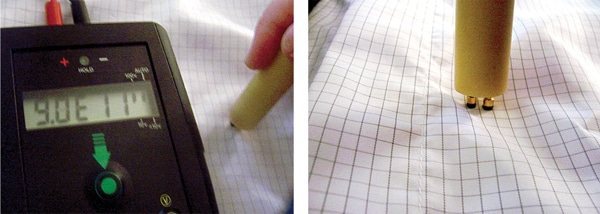

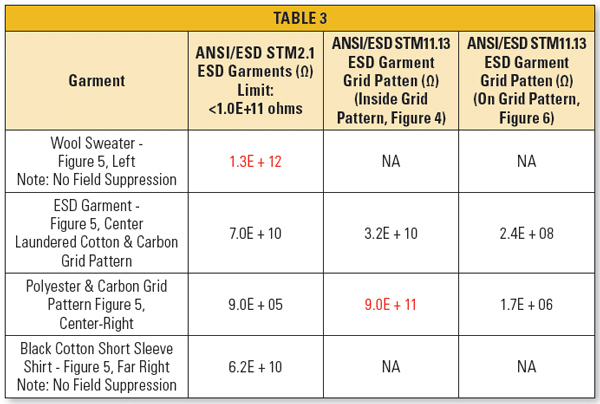
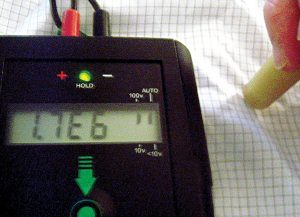

In Figure 7, the antistatic tray was hand-treated and produced a 2-point average resistance measuring 3.6 x 108ohms for the inside cavities and 4.3 x 108 on the bottom (Table 4). The tray was set atop a charge plate to confirm that the overhead 3-fan ionization unit had neutralized the charge to <5.0 volts. An alligator clip was attached to the tray to insure a path to ground. An ESD event antenna was positioned one foot from the ESD sensitive device. While the operator was grounded (wearing a wriststrap), a stainless steel tweezer made direct contact with the pins of the ESD sensitive device (metal-to-metal). Consequently, the test was conducted first wearing a wool sweater; second an ESD cotton blend & carbon grid garment; third, an ESD polyester blend & carbon grid garment; and, finally a black cotton short-sleeve shirt.
The next step constitutes a grounded operator approaching a computer interfaced, non-contact voltage probe. The results are illustrated in Figures 8 to 11.




Within seconds after approaching the non-contact voltage probe and ESD event antenna, the grounded operator wearing the various apparel for each material type made direct metal-to-metal contact with the ESD sensitive device. Consequently, an electrostatic field in proximity to an ESD sensitive device produced a field induced model discharge (FIM) when metal-to-metal contact was made in the presence of an electrostatic field as illustrated in Tables 4 and 5.


Definition of CDM & Field Induction
As a device contacts a conducting surface, discharge to the surface can be very rapid and cause device damage known as CDM (Charge Device Model) Hazard or Field Induced Model Discharge.
Induction is caused by one object or person transferring a charge to another surface. At the point of surface contact, a charge will rapidly discharge onto a conductive surface such as tweezer contact with component pins.
 In summary, charge contribution by ESD garments should be considered when handling ultrasensitive ESD devices under 50 volts or as required by the user. The ESD garment standard test method, ANSI/ESD STM2.1, provides an effective cuff-to-cuff or sleeve-to-sleeve measurement technique as an indicator of resistance performance. Moreover, it was found that without ionization, some fabrics (with and without conductive grids) generated both electrostatic fields that fueled ESD events when metal tweezers made contact with component pins by a grounded operator. In conclusion, this article outlines preliminary findings whereby more research at lower relative humidities and additional testing will be required for a later study.
In summary, charge contribution by ESD garments should be considered when handling ultrasensitive ESD devices under 50 volts or as required by the user. The ESD garment standard test method, ANSI/ESD STM2.1, provides an effective cuff-to-cuff or sleeve-to-sleeve measurement technique as an indicator of resistance performance. Moreover, it was found that without ionization, some fabrics (with and without conductive grids) generated both electrostatic fields that fueled ESD events when metal tweezers made contact with component pins by a grounded operator. In conclusion, this article outlines preliminary findings whereby more research at lower relative humidities and additional testing will be required for a later study.
REFERENCES
1. ESD Adv. 1.0-2009
2. NASA-HANDBOOK-8739.21 & NASA-STD 8739.6
3. ANSI/ESD S20.20-2007
4. ANSI/ESD STM2.1-1997
5. ANSI/ESD STM11.11-2006
6. ANSI/ESD S6.1-2005
7. ESD TR20.20-2008
8. Fed-TM-STD-191A, METHOD 5931, Notice 7, 9 August 2000
9. ESD from A to Z, Kolyer & Watson, Chapman & Hill, 1996
10. Static Control Garment Verification to Ensure Supplier Conformance, Controlled Environments, 23 February 2012, Bob Vermillion, RMV Technology Group at NASA-Ames
ABOUT THE AUTHOR
Bob Vermillion, CPP/Fellow, is a Certified ESD & Product Safety Engineer-iNARTE with subject matter expertise in advanced materials testing and evaluation, troubleshooting robotics and electronic systems for aerospace, disk drive, medical device, pharmaceutical, automotive and consumer electronics. As a member of the ESD garment working group, Bob also serves on the ESDA Standards Committee. Bob is a member of the SAE G-19 & G-21 Committees. Speaking engagements include ESD Seminars in the USA and abroad including guest lecturer seminars for California State Polytechnic University, San Jose State University, University of California at Berkeley and Clemson University. Bob is CEO & Founder of RMV Technology Group, LLC, a NASA Industry Partner and 3rd Party ESD Materials and Systems Level Testing Lab, Training and Consulting Company. You can reach Bob at 650-964-4792 or bob@esdrmv.com.




